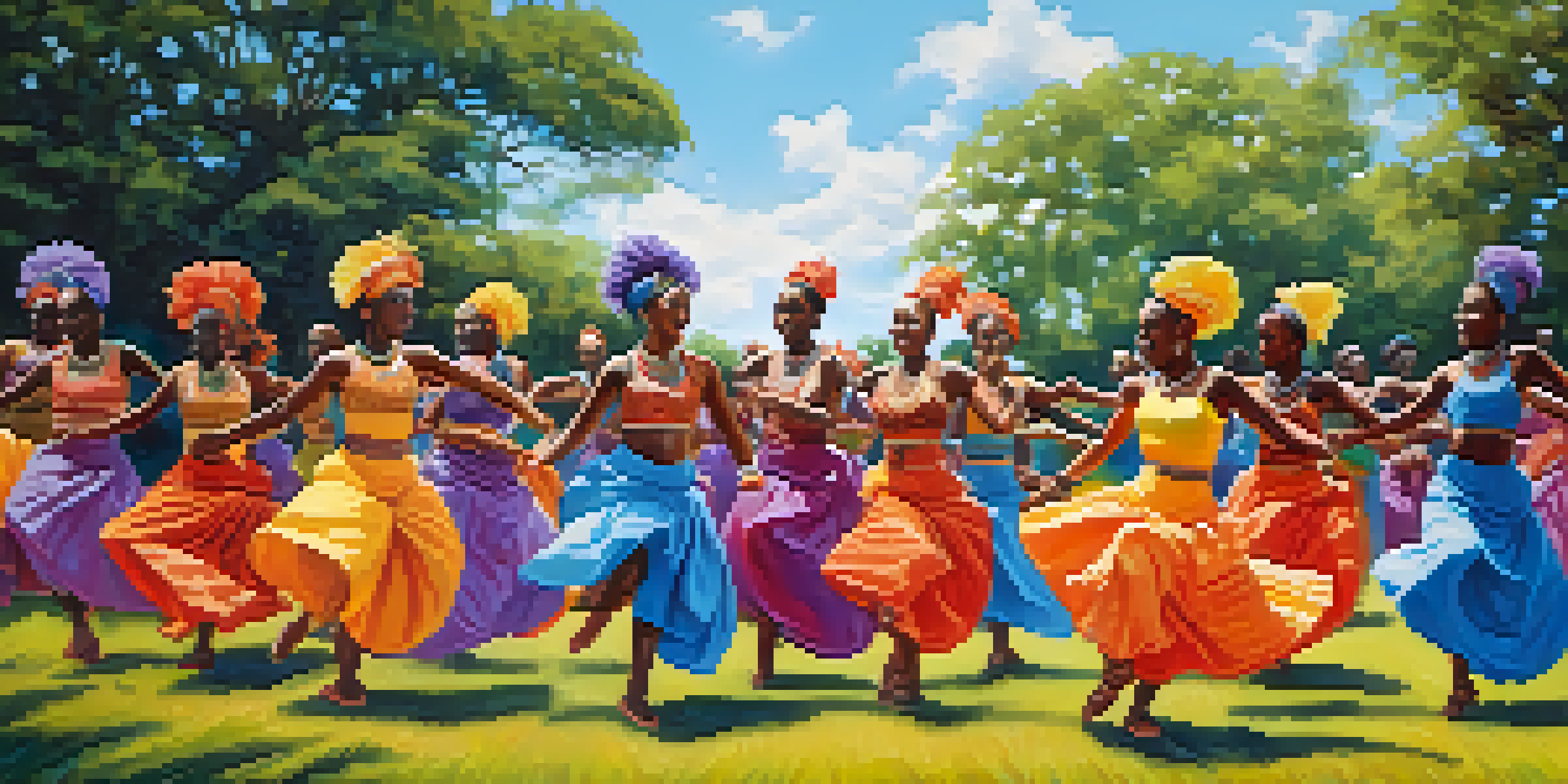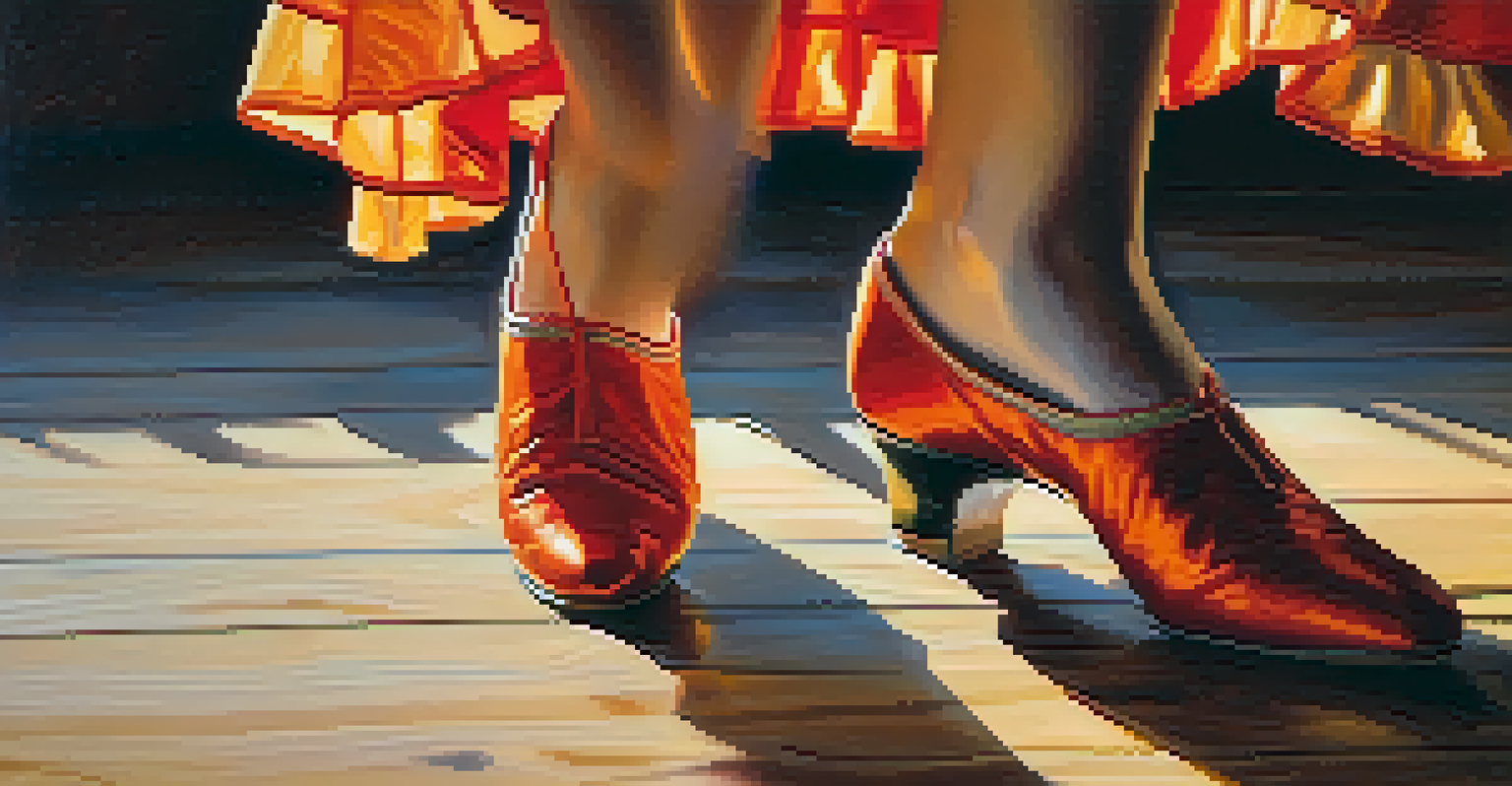Cultural Dance Forms and Their Influence on Emotional Intelligence

Understanding Emotional Intelligence in Cultural Contexts
Emotional intelligence (EI) refers to the ability to identify, understand, and manage emotions. It plays a crucial role in how we engage with others and navigate social environments. In many cultures, dance serves as a unique medium through which emotional expression and understanding can be enhanced, making it a powerful tool for developing EI.
Dance is the hidden language of the soul.
Cultural dances often embody the values, beliefs, and emotions of a community, allowing individuals to connect deeply with their heritage. By participating in these dances, individuals learn to express feelings that might otherwise remain unspoken. This form of non-verbal communication can foster empathy and social awareness, essential components of emotional intelligence.
Moreover, engaging in dance can also help individuals regulate their emotions. The rhythm and movement provide a physical outlet for emotions, which can lead to greater self-awareness. In this way, cultural dance not only reflects emotional states but also facilitates the development of emotional skills.
The Role of Dance in Enhancing Empathy
Many cultural dances tell stories that resonate emotionally with performers and audiences alike. This storytelling aspect encourages participants to step into the shoes of others, fostering empathy. For instance, traditional dances often depict historical events or personal struggles, allowing dancers to connect with and understand diverse perspectives.

As dancers embody different characters or emotions, they practice recognizing and interpreting feelings beyond their own. This practice can translate to everyday life, enhancing their ability to empathize with others. As a result, cultural dance becomes a dynamic way to cultivate a deeper understanding of human experiences.
Dance Enhances Emotional Intelligence
Cultural dance fosters emotional intelligence by allowing individuals to express, understand, and manage their emotions through movement and storytelling.
Furthermore, the shared experience of dancing in a group setting strengthens social bonds and connections. When individuals dance together, they experience a sense of unity and mutual understanding, which further enhances their empathetic abilities. This collective engagement in dance nurtures a supportive environment where emotional intelligence can flourish.
How Dance Fosters Self-Awareness and Regulation
Self-awareness is a critical component of emotional intelligence, and dance can be a powerful vehicle for its development. Through movement, individuals can explore their emotions physically and expressively, gaining insights into their emotional states. This act of self-exploration can lead to a greater understanding of one's feelings and responses.
Emotions are the driving force behind human behavior, and understanding them is key to effective communication.
Moreover, many cultural dances require focus and discipline, which can help individuals learn to regulate their emotions. The practice of mastering complex dance steps or routines encourages patience and persistence, reinforcing the ability to manage frustration or anxiety. As a result, dancers often find themselves better equipped to handle various emotional challenges in life.
Additionally, the reflective nature of dance allows individuals to process emotions in a safe environment. Whether it's through improvisation or structured choreography, dancers can articulate their feelings, leading to healthier emotional expression. This process of reflection and expression ultimately contributes to enhanced self-regulation and emotional intelligence.
Cultural Dance as a Tool for Building Social Skills
Participating in cultural dance often involves collaboration with others, making it a great way to develop social skills. Dancers learn to communicate effectively, work as a team, and navigate group dynamics. These interactions can significantly enhance interpersonal skills, which are vital for emotional intelligence.
For example, many traditional dances require synchronization with others, fostering a sense of cooperation and mutual respect. This collaboration encourages dancers to listen to one another, both musically and emotionally, which can lead to strengthened relationships. As they engage in these social interactions, they become more adept at recognizing social cues.
Empathy Grows Through Dance Stories
Participating in cultural dances helps individuals develop empathy by encouraging them to connect with diverse perspectives and experiences.
Additionally, cultural dances often celebrate community and connection. This sense of belonging can boost confidence and self-esteem, further enhancing social skills. Through these communal experiences, individuals can practice their emotional intelligence, making them more effective communicators and collaborators in various aspects of life.
The Therapeutic Benefits of Dance on Emotional Health
Dance therapy has gained recognition for its ability to promote emotional well-being. By tapping into the expressive nature of dance, individuals can release pent-up emotions and stress. This therapeutic aspect of dance not only supports mental health but also enhances emotional intelligence by encouraging emotional exploration.
Cultural dance forms often incorporate elements of ritual and tradition, which can provide a sense of grounding and stability. Engaging in these practices may help individuals cope with emotional challenges, as they find solace in their cultural roots. This connection to heritage can foster resilience and emotional awareness.
Furthermore, the joy and exhilaration that dance brings can significantly improve mood and emotional states. Regular participation in dance can lead to increased endorphin levels, contributing to a more positive outlook on life. As individuals experience these uplifting emotions, they become more attuned to their own feelings, leading to greater emotional intelligence.
Examples of Cultural Dances and Their Emotional Impact
Every culture has its unique dance forms, each carrying deep emotional significance. For example, the expressive movements of Flamenco can convey passion and heartache, allowing dancers to explore their emotions deeply. This allows participants to connect with the feelings of love, loss, and joy, enhancing their emotional intelligence.
Similarly, the joyful rhythms of African dance often celebrate community and resilience. These dances encourage participants to express happiness and unity, fostering emotional connections among dancers. The communal aspect of these dances reinforces the importance of shared emotional experiences in building emotional intelligence.
Dance Builds Social Skills
Engaging in cultural dance promotes social skills as dancers learn to communicate effectively and collaborate within a group setting.
In contrast, the somber yet powerful movements of traditional Indian dance forms like Kathak can reflect profound emotions such as sorrow or longing. Dancers embody these emotions, promoting a deeper understanding of complex feelings. Such experiences are invaluable for developing emotional intelligence, as they encourage individuals to confront and articulate their own emotional landscapes.
Conclusion: The Lasting Impact of Dance on Emotional Intelligence
Cultural dance forms play a significant role in shaping emotional intelligence across societies. Through movement, storytelling, and collaboration, individuals can explore their emotions, enhance empathy, and build self-awareness. These experiences not only enrich personal growth but also contribute to healthier social interactions.
As we recognize the powerful connection between dance and emotional intelligence, it becomes clear that encouraging participation in cultural dance can be beneficial for individuals of all ages. Whether through formal lessons or informal gatherings, dance fosters an environment where emotional skills can thrive.

Ultimately, the influence of cultural dance on emotional intelligence is a testament to the power of art in human connection. By celebrating our diverse dance traditions, we not only honor our heritage but also nurture the emotional intelligence that binds us together as a community.